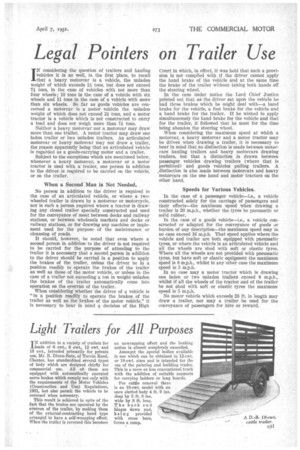Legal Pointers on Trailer Use
Page 79

If you've noticed an error in this article please click here to report it so we can fix it.
IN considering the question of trailers and hauling vehicles it is as well, in the first place, to recall that a heavy motorcar is a vehicle, the unladen weight of which exceeds 21 tons, but does not exceed 7i tons, in. the case of vehicles with not more than four wheels; 10 tons in the case of a vehicle with six wheels and 11 tons in the case of a vehicle with more than six wheels. So far as goods vehicles are concerned a motorcar is a motor vehicle the unladen weight of which does not exceed 21 tons, and a motor tractor is a vehicle which is not constructed to carry a load and does not weigh more than 7i tons.
Neither a heavy motorcar nor a motorcar may draw more than one trailer. A motor tractor may draw one laden trailer or two unladen trailers. An articulated motorcar or heavy motorcar may not draw a trailer, the reason apparently being that an articulated vehicle is regarded as a goods-carrying motor and a trailer.
Subject to the exceptions which are mentioned below, whenever a heavy motorcar, a motorcar or a motor tractor is used with a trailer, one person in addition to the driver is required to be carried on the vehicle, or on the trailer.
When a Second Man is Not Needed.
No person in addition to the driver is required in the case of an articulated vehicle, or where a twowheeled trailer is drawn by a motorcar or motorcycle, nor is such a person required where a tractor is drawing any closed trailer specially constructed and used for the conveyance of meat between docks and railway stations, or between wholesale markets and docks or railway stations, or for drawing any machine or implement used for the purpose of the maintenance or cleansing of roads.
It should, however, be noted that even where a second person in addition to the driver is not required to be carried for the purpose of attending to the trailer it is necessary that a second person in addition to the driver should be carried in a position to apply the brakes of the trailer, unless the driver be in a position readily to operate the brakes of the trailer as well as those of the motor vehicle, or unless in the case of a trailer not exceeding a ton in weight unladen the brakes of the trailer automatically come into operation on the overrun of the trailer.
When considering whether the driver of a vehicle is "In a position readily to operate the brakes of the trailer as well as the brakes of the motor vehicle," it is necessary to bear in mind a decision of the High
Court in which, in effect, it was held that such a provision is not complied with if the driver cannot apply the hand brake of the vehicle and at the same time the brake of the trailer without taking both hands off the steering wheel.
In the case under notice the Lord Chief Justice pointed out that as the driver sat upon the vehicle be had three brakes which he might deal with—a hand brake for the vehicle, a foot brake for the vehicle and a hand brake for the trailer, If be wished to apply Simultaneously the hand brake for the vehicle and that for the trailer, it followed that he must for the time being abandon the steering wheel.
When considering the maximum speed at which a motorcar, a heavy motorcar and a motor tractor may be driven when drawing a trailer, it is necessary to bear in mind that no distinction is made between motorcars hauling trailers and heavy motorcars drawing trailers, but that a distinction is drawn between passenger vehicles drawing trailers (where that is permitted) and goods vehicles pulling trailers. A ,distinction is also made between motorcars and heavy motorcars on the one hand and motor tractors on the other hand.
Speeds for Various Vehicles.
In the case of a passenger vehicle—i.e., a vehicle constructed solely for the carriage of passengers and their effects—the maximum speed when drawing a trailer is 20 m.p.h., whether the tyres be pneumatic or solid rubber,.
In the case of a goods vehicle—i.e., a vehicle constructed or adapted for the conveyance of goods or burden of any description—the maximum speed may in no case exceed 16 m.p.h. That speed applies where the vehicle and trailer are both equipped with pneumatic tyres, or where the vehicle is an articulated vehicle and all the wheels are shod with soft or elastic tyres. Where all the wheels are not provided with pneumatic tyres, but have soft or elastic equipment-the maximum speed is 8 m.p.h., whilst in any other case the maximum speed is 5 m.p.h.
In no case may a motor tractor which is drawing one laden or two unladen trailers exceed 8 m.p.h., Whilst if all the wheels of the tractor and of the trailer be not shod with soft or elastic tyres the maximum speed is 5 m.p.h.
No motor vehicle which exceeds 26 ft. in length may draw a trailer, nor may a trailer, be used for the conveyance of passengers for hire or reward.




























































































































